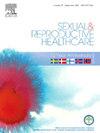创伤性分娩经历与创伤后应激障碍:冰岛版城市出生创伤量表(City BiTS)的心理测量特征
IF 1.7
3区 医学
Q3 PUBLIC, ENVIRONMENTAL & OCCUPATIONAL HEALTH
引用次数: 0
摘要
目的探讨冰岛城市出生创伤量表(City BiTS)的心理测量特征,评估冰岛人口中与分娩相关的创伤后应激症状和创伤后应激障碍的患病率。方法将City BiTS翻译成冰岛语,进行面孔效度测试(n = 6)。数据是在2022年对产后6-12周的母亲(n = 616)进行的在线横断面调查中收集的。采用探索性因子分析(EFA)对潜在因子结构进行检验。内部一致性采用Cronbach 's alpha和McDonald 's Omega进行评估。采用Spearmańs与出生满意度修正量表(BSS-R)和爱丁堡产后抑郁量表的等级相关来评估收敛效度。通过与BSS-R的相关性来探讨区分效度。采用Mann-Whitney U检验和Kruskal-Wallis检验评估组间差异。Dunn的配对检验是针对两组以上的变量进行的。结果616例产妇中,15.6%有分娩创伤经历,2.4%符合分娩相关创伤后应激标准。EFA显示,包括出生相关症状和一般症状的双因素模型最适合。冰岛版City BiTS的内部一致性很好;出生相关症状子量表(α = 0.88,麦当劳ω = 0.91);一般症状分量表(α = 0.87,麦当劳ω = 0.89)。该版本的城市创伤后应激障碍量表是冰岛第一个根据DSM-5标准评估分娩相关创伤后应激障碍的量表,并为临床和研究提供了一个双因素模型。后续研究应进一步验证跨不同人群和环境的双因素结构。本文章由计算机程序翻译,如有差异,请以英文原文为准。
Traumatic birth experience and posttraumatic stress disorder: The psychometric properties of the Icelandic version of the City Birth Trauma Scale (City BiTS)
Objective
The aim of this study was to investigate the psychometric properties of the Icelandic City Birth Trauma Scale (City BiTS) and assess the prevalence of childbirth related post-traumatic stress symptoms and post-traumatic stress disorder in the Icelandic population.
Methods
The City BiTS was translated to Icelandic and tested for face-validity (n = 6). Data was collected in 2022 in an online cross-sectional survey among mothers 6–12 weeks postpartum (n = 616). Exploratory Factor Analysis (EFA) was used to test the underlying factor structure. Internal consistency was assessed using Cronbach’s alpha and McDonald’s Omega. Convergent validity was evaluated with Spearmańs rank correlation with Birth Satisfaction Scale Revised (BSS-R) and Edinburgh Postnatal Depression Scale. Discriminant validity was explored through correlations with BSS-R. Mann-Whitney U test and Kruskal-Wallis test was used for assessment of group differences. Dunn’s paired tests were conducted for variables with more than two groups.
Results
Of 616 women, 15.6 % had traumatic birth experiences and 2.4 % fulfilled the criteria of childbirth-related post-traumatic stress. EFA showed that a two-factor model presented the best fit, comprising birth-related symptoms and general symptoms. Internal consistency of the Icelandic version of City BiTS was good; for birth-related symptoms subscale (α = 0.88, McDonald’s omega = 0.91); for general symptoms subscale (α = 0.87, McDonald’s omega = 0.89).
Conclusions
This version of the City BiTS is the first measurement in Icelandic, assessing childbirth-related PTSD according to DSM-5 criteria and provides a two-factor model for clinical and research purpose. Subsequent research should further validate the two-factor structure across diverse populations and settings.
求助全文
通过发布文献求助,成功后即可免费获取论文全文。
去求助
来源期刊

Sexual & Reproductive Healthcare
PUBLIC, ENVIRONMENTAL & OCCUPATIONAL HEALTH-
CiteScore
2.70
自引率
5.60%
发文量
73
审稿时长
45 days
 求助内容:
求助内容: 应助结果提醒方式:
应助结果提醒方式:


